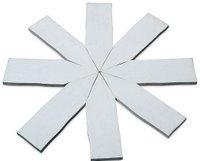Tuesday, January 17, 2006
Notes on Richard Tuttle at the Whitney
Some random observations on the Richard Tuttle exhibition now at the Whitney:


- If you've already seen the exhibition once, you've haven't seen it yet. This is the exhibition that just won't stand still. There are a couple reasons for this. First, the show was organized by SFMOMA which had more space to give to it than the Whitney does. And, second, for his 1975 show at the Whitney, Tuttle and curator Marcia Tucker designed multiple installations. The exhibition was actually hung and then re-hung three times over the course of its run. As an homage to that exhibition and to give more work a showing in New York, the Whitney made plans to swap certain pieces in and out of this exhibition. The Whitney's own work, Fountain (at right) for example, was recently removed from the show.
- Now that the show has been up and open for a while, this installing and re-installing seems to have taken on a life of its own. Every time I've seen the show over the last month there have been changes. On Sunday when I arrived to give a gallery talk, I noticed that a series of pieces that played a pivotal role in my lecture had disappeared during the previous week. I had five minutes to look for something else that I could call "a surreal Mensa test" because I thought the phrase was cute and didn't want to drop it from my talk. Guess what? I found another surreal Mensa test without any difficulty. Most of Tuttle's series from the mid-1980s, actually, can be called surreal Mensa tests.
- I'm almost expecting, one of these weekends, to walk onto the museum's third floor to find all the temporary walls removed and a single, small work installed on the floor in the middle of an otherwise empty gallery. Won't it be a challenge to try to talk about that for 45 minutes?
- On Sunday I watched a guy walk right into the middle of Tuttle's floor piece Ten Kinds of Memory and Memory Itself which was installed two weeks ago for the first time since (I've been told) 1975. The trespasser finally realized that the guards and I were shouting at him after he had miraculously stepped over several of the string drawings without kicking into any of them. His response: "Sorry. I didn't see anything there." That's always a danger with Tuttle's work, isn't it?
- I recently read Hilton Kramer's famously nasty review of the 1975 show that appeared in the Times when he was art critic for the paper of record, and I'm deeply conflicted about it. (Sorry, I can't find a copy on-line, and I'm not about to retype it here.) On the one hand, it's an incredibly witty, muscular piece of prose that expresses a firm opinion on the show--things we almost never see in art writing today. On the other hand, it's typical Kramer in its writing off of a whole body of work without expending an iota of energy to try to understand something that questions his critical assumptions. I think this is the piece that Saint Peter will pull out some day when Kramer arrives at the Pearly Gates: "Hilton, I've got to tell you. You were given a lot of talent, much more than your share actually, but just look at how you chose to use it...."
- The exhibition has the most beautifully produced catalogue I have seen in recent years. But don't just take my word for it. Find and browse a copy for yourself. You won't be disappointed.
- Update: Browsing the WPS1 archives, I came across this interview (Real Player required) with the show's curator David Kiehl. Jump forward to 21:25 of the stream to hear Kiehl discuss the installation.